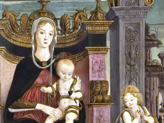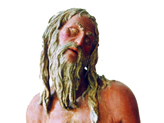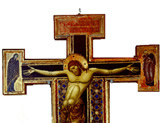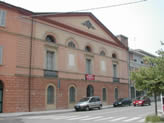Pinacoteca Comunale - Faenza
Via Santa Maria dell'Angelo, 9 48018 Faenza
Tel. 0546 660799 Fax 0546 660760
email info@pinacotecafaenza.it
web http://pinacotecafaenza.racine.ra.it/ita/visita.htm
Apertura: da ottobre a maggio, sabato e domenica, ore 10-16; da giugno a settembre, sabato e domenica, ore 10-13 e 15-19.
Ingresso gratuito
Accessibile ai diversamente abili
A seguito del continuo incremento delle raccolte, la Pinacoteca venne regolarmente aperta al pubblico nel 1879, nell'ex convento dei Gesuiti. Da allora, e fino ai nostri giorni, il patrimonio artistico è stato notevolmente aumentato da ricche donazioni di privati, da depositi di Enti pubblici, dai reperti archeologici emersi a seguito delle attività edilizie.
Chiusa al pubblico per molti anni - anche se una parte delle collezioni è stata visitabile presso Palazzo Milzetti di Faenza - la Pinacoteca ha riaperto ufficialmente il 19 marzo 2005.
Le collezioni della Pinacoteca sono ripartite in due sezioni: la Sezione Antica e la Galleria d'Arte Moderna. La Sezione Antica presenta un'ampia panoramica d'arte e storia dall'età romana al secolo XVIII: mosaici, lapidi, sculture ed epigrafi romane ed altomedievali.
La parte più consistente e qualificata delle raccolte è costituita da dipinti e sculture che consentono di percorrere cinque secoli d'arte faentina e italiana. I fondi del '200 e '300 sono ridotti, ma di grande valore. Ben più ampio è il panorama offerto dalle opere del '400 e '500; oltre alle tavole tardogotiche, grande rilevo occupano gli artisti che hanno diffuso il Rinascimento a Faenza: Biagio d'Antonio, G. B. Bertucci il Vecchio, Marco Palmezzano, Donatello, A. Rossellino e il Maestro della Pala Bertoni.
Imponente è la raccolta di pale d'altare del '500 e '600 "emigrate" dalle chiese di Faenza: documentano la vitalità della cultura artistica nell'ambito del manierismo che culmina in Ferraù Fenzoni, l'artista che fa da ponte verso il secolo barocco. Fra i nuclei tematici di maggiore spicco: le nature morte di Recco, Ruoppolo, Boselli, Resani, Magini e Levoli, con i quali si entra nel sec. XVIII. Di questo periodo sono i paesaggi, le battaglie, i dipinti di genere, spesso anonimi, talvolta di artisti notevoli: A. Locatelli, S. Orlandi, G. Bucci e F. Guardi.
Il primo nucleo della Galleria d'Arte Moderna si costituisce nel 1879, allorché F. Argnani si preoccupò di inserire nel percorso espositivo anche alcune opere di autori contemporanei. Nei decenni successivi - grazie ad acquisti e soprattutto a donazioni sempre più numerose - i fondi di pittura e scultura dell'800 e '900 sono cresciuti a tal punto da porre il problema di spazi espositivi adeguati.
I fondi sono raggruppati per scuole e tendenze storico-stilistiche: Neoclassicismo e Purismo (F. Giani, M. Sangiorgi, T. Minardi, P. Piani, G. Landi); Romanticismo e Realismo (R. Liverani, M. D'Azeglio, V. Hugo, G. Fattori, A. Berti T. Dalpozzo ed altri comprimari di interesse locale). Di recente acquisizione alcuni dipinti di scuola francese dell'800, a cui si affiancano le due sculture di A. Rodin.
Di straordinario rilievo il fondo delle opere di Domenico Baccarini, il protagonista dell'intenso rinnovamento artistico dei primi anni del '900, e dei suoi amici e coetanei (il Cenacolo Baccarini), che ne prolungarono per più di mezzo secolo la lezione innovatrice. Oltre a questo nucleo sono presenti opere di maestri del '900 italiano (G. Morandi, A. Tosi, A. Martini, F. De Pisis) e di autori faentini e romagnoli.
Ricordiamo infine il Gabinetto Disegni e Stampe: già il nucleo iniziale della Pinacoteca, costituito dalla collezione di G. Zauli, comprendeva una consistente raccolta di stampe e disegni. Da allora fino ad oggi il fondo di grafica è aumentato fino a raggiungere dimensioni notevoli, quantificabili in circa 20.000 fogli. Sono presenti i nomi più alti dell'incisione europea, da A. Dürer fino ai contemporanei.
° ° ° °° ° ° ° ° ° °° ° ° °° ° °° ° ° ° °° °° ° °° ° °° °° ° °° ° °° ° °° °° ° °° ° °° ° ° °°
The Faenza Municipal Gallery is the oldest museum in Faenza, housed by the ex-monastery of the Jesuits. Records documenting its inception date back as far as 1797, when the city council acquired a large collection of prints, drawings and paintings by the artist Giuseppe Zauli, founder and first director of the Municipal School of Art.
To this initial nucleus, in the same year and in those immediately after, works of art were added from the churches and convents closed under Napoleonic law.
1867 heralded the second, significant enlargement of the gallery's artistic heritage, thanks to the ecclesiastical suppressions. Until 1875, the lives of the School of Art and of the Art collections followed the very same course, which was also due to the fact that prints and paintings of the collection were used as teaching materials for the students.
The achievement of all this work was the opening, in February 1879, of the Gallery and adjoining Civic Museum to the public, with a collection comprising printings, sculptures, archaeological materials, coins and artefact documenting the history, even quite recent, of the city. In 1881, the curator ship Argnani also published the first printed catalogue of the collections.
In the years that followed, important accessions were many, such as those of the works of Domenico Baccarini and a growing number of donations on the part of private citizens.
Problems caused by both the lack of space as well as coexistence with a local high school persisted until 1988, the year in which the Gallery was officially closed to allow the inevitable renovation work and upgrading of the rooms which, as they stand today, were re-opened on 19 March 2005.
The collection is divided in two sections: the Ancient Art Gallery and the Gallery of Modern Art.
The Ancient Gallery houses, between the others, the Donatello Room, which presents an overview of the Faenza artistic Renaissance. In the centre is the wooden polychrome sculpture portrait Saint Jerome, attributed to Donatello since Vasari. It has given rise to lengthy, and still ongoing, critical debate as regards Donatello's authorship and possible intervention on the part of his apprentices.
Some of the most important masterpieces of the Gallery are also housed in the hall, whose splendour is due, among other things, to the emergence from the shadows of a large group in glazed terracotta by Alfonso Lombardi.
Finally a spacious hall is used to house the large altarpieces of the 16th and 17th, which once decorated the altars of the most important churches of Faenza. Among the works of the early 1500's is the Baptism of Christ by Luca Scaletti, while the two panels by Jacopone da Faenza are emblematic of Faenza Mannerism, with direct links to the religious artistic sites in Rome. Finally Ferraù Fenzoni represents the divide, and not just chronological, between two centuries.
Instead the Gallery of Modern Art, constituted in 1879, houses sculptures and paintings dating back to the early decades of the twentieth century, documenting in particular the work of Faenza-born Domenico Baccarini, Ercole Drei and Domenico Rambelli. All three artists had the same training, at the local municipal school of art in the early twentieth century, and would remain good friends. Remarkable is the vast collection of works by Baccarini, which includes 28 paintings, over 30 sculpture and 154 drawings.
Also the still life genre reached its eight in the eighteenth centuries, witnessing important developments in Emilia Romagna itself. Most of the artists in this genre (like Carlo Magini and Giovanni Battista Ruoppolo) are present in the Gallery thanks to the generosity of count Luigi Zauli Naldi who donated works of considerable value and allowed for the critical and historical rediscovery of the entire still life genre.
Finally one of the most fascinating paintings in the Modern Gallery is the Portrait of a Magistrate. The identification of the artist has given rise to an intense debate. It is most certainly the work of a great portrait artist, probably not Italian, and the latest and highly tentative proposal is Jacob Ferdinand Voet.




